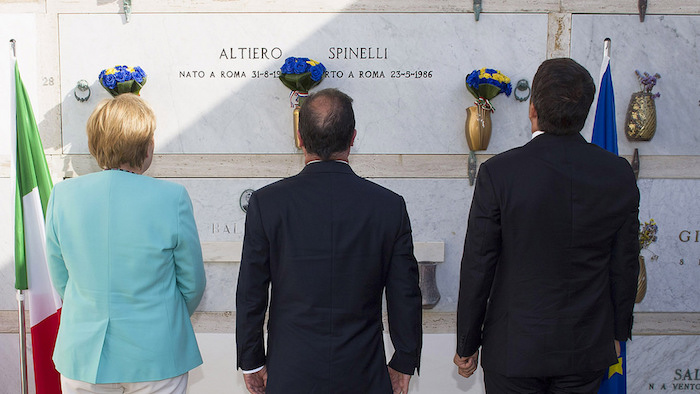Almost two month have already passed. Angela Merkel, François Hollande and Matteo Renzi had chosen a pair of sun-drenched rocks in the middle of the Mediterranean to prepare the great European “relaunch” they promised in the aftermath of the UK referendum on Brexit. This surprising detour was no summer getaway, but rather a highly symbolic choice. In fact, 75 years ago in 1945, on the very same island of Ventotene, a few anti-fascist resistants in exil led by Altiero Spinelli launched an appeal for European political unity.
At a time when Europe seems stuck in a democratic impasse, appealing to the spiritual legacy of a ‘founding father’ was an inspired choice, especially since he was one of the most clear-sighted opponents of the technocratic impulses of the famous “Monnet method”, which based political union upon the construction of a giant market. As a figurehead of Italian socialism and at the same time a tireless theoretician of the “European people’s” sovereignty, Altiero Spinelli had notably encouraged – between 1955 and 1962 – a vast transnational mobilisation to convene a “European people’s congress”, which brought together almost 700,000 supporters across Europe. The composition of the “Cahiers de doléance" in the six founding member states (cf. Revendications du peuple européen, 1962) would lead to the first version of a Europe-wide constituent assembly. Yet except for a few ritual references to the “founding father”, the three European leaders ultimately never mentioned the “European people”, nor the transnational democratic revolution that Spinelli obsessed over. Instead they proposed a Europe of borders, defence and security as the sole shared political horizon. Such a warping of memory would doubtless not be worth mentioning, but for the fact it reveals the wider mythical relationship we have now towards the history of the “European project”.
The European Union is indeed haunted by the “grand narrative” of its inexorable development. Europe’s institutions have relentlessly focused on the construction of a “European pantheon” of founding fathers to the point of saturating the “European project” with myths and symbols. It takes as its initial prophecy the Schuman declaration” of 9 May 1950, which paved the way towards the European Communities. This teleological narrative has been rehashed time and again, and is now ultimately ensnaring us. With our eyes fixed on the EU’s ultimate future development into a European democracy, we have only regarded the recent series of European “crises” as opportunities for “relaunching” the project, neglecting any social and economic contradictions and the democratic impasses that they reveal. Worse still, in reciting the EU’s history as if it were a deployment of a project, we have opened up the possibility that it will be rejected as a whole. Whether negative or positive, a mythological relationship to the European “project” has emerged which seems to condemn us to chose between the status quo of a Brussels-based politics navigating by sight alone and the “sovereigntists’” total rejection.
To loosen this knot and escape this defensive game, it is now more necessary than ever to “remake” European history and to remember that the EU has never been a monolithic “bloc” free from the contestations and conflicts that we now retrospectively see. Far from being “built in a day”, Europe’s current trajectory is the result of a number of bends and forks in the road. There has been a progressive shift in the Union’s objectives away from its social considerations (the “reinforcement of economic and social cohesion” or the “equal access to progress” set out in the Treaties of Rome) and towards the freedoms of movement and competition, which have been elevated to the level of a fundamental value. There has also been a shift in its methods of integration, abandoning the voluntarist project of (economic, social and fiscal) harmonisation and of cohesion (through structural funds, etc.). Finally, there has been a shift in its doctrines, moving away from an industrial policy that respected public services towards a ever more neoliberal preference for private management, subcontracting, even privatisation, etc.
By bringing to light the great shifts of Europe’s development, we can rediscover the trace of these multiple “possible Europes” which were progressively sidelined and are now completely forgotten. It is a way of remembering that there was a time when trade unions had a representative in the Commission and even in the Court of Justice. A time when Europe defended an industrial policy that was relatively independent of the clamour for unhindered competition. Finally, a time when Keynesian ideas held support in the Commission. Not that there was ever a “golden age” for the “European project” – totally improbable in a Europe that has always been dominated by the agenda of unifying markets and economic freedoms. But it is useful as a way to remind ourselves that Europe has in fact never been carved in stone, contrary to what a lot of people claim.
The Single Market and the eurozone crisis have of course consolidated the EU’s neoliberal direction, but it remains riven with internal contradictions. These alternative European projects (social harmonisation, fiscal cooperation, defence of human rights, promotion of equality and of democracy within the EU) have been thwarted or sidelined over the course of Europe’s history. But they continue to operate from within. They are the “objectives” and “values” inscribed in the opening sections of European treaties (the section on “Solidarity” in the Charter on Fundamental Rights, the Preamble to the Lisbon Treaty evoking “fundamental social rights”, etc) which give visibility to the European project’s “unkept promises”. It is often the marginal institutions that represent this other Europe within the EU (the structural funds, the small but mighty European Committee of Social Rights). Finally, it is the external groupings (unions of European civil servants resisting the introduction of the New Public Management, NGOs like CEO, Finance Watch or AlterEU – fighting against the grip of lobbyists on the European legislative process, etc.). These internal reserves of democracy and critique, which exist despite everything around European institutions, are not enough alone to reorient the course of the European project. But it is with these points of support that we may be able to carve out some room for political manoeuvre, and give back some semblance of credibility to this European democratic alternative that Altiero called for so passionately.
Was this article useful? If so we are delighted!
It is freely available because we believe that the right to free and independent information is essential for democracy. But this right is not guaranteed forever, and independence comes at a cost. We need your support in order to continue publishing independent, multilingual news for all Europeans.
Discover our subscription offers and their exclusive benefits and become a member of our community now!












